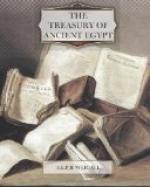Nothing, of course, could yet be touched, and for several days, during the lengthy process of photographing and recording the contents of the tomb in situ, no further information could be obtained as to the identity of the owner of the tomb. The shrine was certainly made for Queen Tiy, and so too were the toilet utensils, judging by an inscription upon one of them which gave the names of Tiy and her husband, King Amenhotep III., the parents of Akhnaton. It was, therefore, not a surprise when a passing doctor declared the much broken bones to be those of a woman—that is to say, those of Queen Tiy. For reasons which will presently become apparent, it had been difficult to believe that Akhnaton could have been buried in this Valley, and one was very ready to suppose that the coffin bearing his name had but been given by him to his mother.
The important discovery was now announced, and considerable interest and excitement. At the end of the winter the various archaeologists departed to their several countries, and it fell to me to despatch the antiquities to the Cairo Museum, and to send the bones, soaked in wax to prevent their breakage, to Dr Elliot Smith, to be examined by that eminent authority. It may be imagined that my surprise was considerable when I received a letter from him reading—“Are you sure that the bones you sent me are those which were found in the tomb? Instead of the bones of an old woman, you have sent me those of a young man. Surely there is some mistake.”
There was, however, no mistake. Dr Elliot Smith later informed me that the bones were those of a young man of about twenty-eight years of age, and at first this description did not seem to tally with that of Akhnaton, who was always thought to have been a man of middle age. But there is now no possibility of doubt that the coffin and mummy were those of this extraordinary Pharaoh, although the tomb and funeral furniture belonged to Queen Tiy. Dr Elliot Smith’s decision was, of course, somewhat disconcerting to those who had written of the mortal remains of the great Queen; but it is difficult to speak of Tiy without also referring to her famous son Akhnaton, and in these articles he had received full mention.
About the year B.C. 1500 the throne of Egypt fell to the young brother of Queen Hatshepsut, Thutmosis III., and under his vigorous rule the country rose to a height of power never again equalled. Amenhotep II. succeeded to an empire which extended from the Sudan to the Euphrates and to the Greek Islands; and when he died he left these great possessions almost intact to his son, Thutmosis IV., the grandfather of Akhnaton. It is important to notice the chronology of this period. The mummy of Thutmosis IV. has been shown by Dr Elliot Smith to be that of a man of not more than twenty-six years of age; but we know that his son Amenhotep III. was old enough to hunt lions at about the time of his father’s death, and that he was already married to Queen Tiy a year




